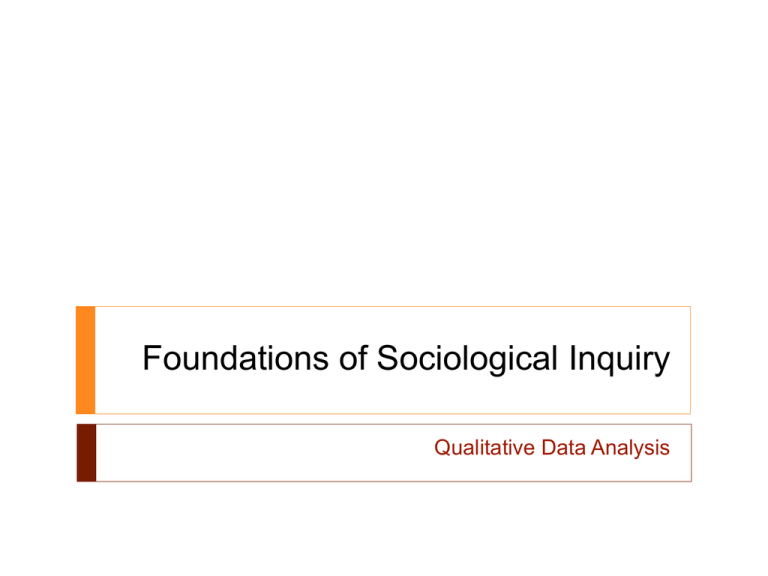The Practice of Social Research
advertisement

Foundations of Sociological Inquiry
Qualitative Data Analysis
Today’s Objectives
Discuss Your Fieldwork
How to Become an Ethnographer
Linking Theory and Analysis
Qualitative Data Processing
Ethics and Qualitative Data Analysis
Questions?
What Did You Do For Your Bus
Ethnography?
What Did You Do For Your Bus
Ethnography?
Ride the Bus
What Did You Do For Your Bus
Ethnography?
Ride the Bus
Observe
What Did You Do For Your Bus
Ethnography?
Ride the Bus
Observe
Record
What bus number did you ride?
0
3
7
4
I RODE BUS 71
2
2
2
1
1
Matched Acceptable Value: NA, Within Range: 7
Acceptable Value: NA, Acceptable Range: {0, 1000}
What did you observe?
1.
2.
3.
4.
People
Places
Actions
All of the above
96%
4%
1
0%
2
0%
3
4
What did you record?
1.
2.
3.
4.
5.
Sights
Sounds
Smells
Feelings
All of the above
64%
28%
4%
1
2
1%
3
3%
4
5
What did you learn?
1.
2.
3.
4.
How to observe
social life
How to take notes
and record my
observations
How to be an
ethnographer
I don’t know
37%
28%
22%
12%
1
2
3
4
Are you done yet?
1.
2.
3.
Yes
No
I don’t know
94%
5%
1
2%
2
3
Theory
Theory – deals with the logical aspect of science –
providing systematic explanations for observations
Theory
Theory – deals with the logical aspect of science –
providing systematic explanations for observations
Remember our example of the coin. We drop a coin, and
it falls. We repeat our experiment over and over and over
again. Each time, the coin falls. (Gravity)
Inverse square law (Newton)
Theory of relativity (Einstein)
Theory
Theory – deals with the logical aspect of science –
providing systematic explanations for observations
Remember our example of the coin. We drop a coin, and
it falls. We repeat our experiment over and over and over
again. Each time, the coin falls. (Gravity)
Inverse square law (Newton)
Theory of relativity (Einstein)
Between 1946-1964 Americans had more children, at
younger ages, than any time before or since. (Baby
Boom)
Economic prosperity (Butz & Ward)
Relative income (Easterlin)
Cultural shifts (Blake & das Gupta)
Which theory best explains the baby boom?
1.
2.
3.
4.
Economic prosperity
(Butz and Ward)
Relative income
(Easterlin)
Cultural shifts (Blake
and das Gupta)
I need more
evidence
72%
10%
1
11%
2
7%
3
4
Qualitative Data Analysis
Qualitative analysis – the non-numerical examination
and interpretation of observations, for the purpose of
discovering underlying meanings and patterns of
relationship.
Linking Theory and Analysis
Discovering Patterns
Frequencies, Magnitudes, Structures, Processes,
Causes, Consequences
Linking Theory and Analysis
Discovering Patterns
Frequencies, Magnitudes, Structures, Processes,
Causes, Consequences
Linking Theory and Analysis
Discovering Patterns
Frequencies, Magnitudes, Structures, Processes,
Causes, Consequences
Cross-case analysis – an analysis that involves an
examination of more than one case; this can be either a
variable-oriented or case-oriented analysis.
Variable-oriented analysis – an analysis that describes and/or
explains a particular variable.
Case-oriented analysis – an analysis that aims to understand a
particular case or several cases by looking closely at the details
of each.
Orthelia did a qualitative study of drug users, with a
particular focus on the factors associated with greater
or lesser use of drugs. Which one of the following did
she study?
87%
1.
2.
3.
4.
5.
frequencies
structures
processes
causes
groups
6%
1
1%
2
3%
3%
3
4
5
Qualitative Data Processing
Coding
– the initial classification and labeling of concepts in qualitative
data analysis.
– a reanalysis of the results of open coding aimed at identifying
the important, general concepts.
– building on the results of initial coding and the identification of
important, general concepts, identify the central concept that
organizes the other concepts that have been identified in a body
of textual materials.
Example codes?
Summarizing results
Establish common themes
Summarizing results
Establish common themes
Summarize frequencies, magnitudes, structures,
processes, causes, consequences from an analysis
of codes
Variable oriented
Case oriented
Summarizing results
Establish common themes
Summarize frequencies, magnitudes, structures,
processes, causes, consequences from an analysis
of codes
Variable oriented
Case oriented
Situate your results in relation to what we think we
already know (e.g., previous research and theory)
Evaluating the Quality of Qualitative
Research
Validity
Reliability
High Reliability and High Validity
• ••
•
•
• ••
• • •
.
27
High Reliability and High Validity
(Self-reported educational attainment)
• ••
•
•
• ••
• • •
.
28
High Reliability and Low Validity
•••••••• ••
•• • ••• ••
•
.
29
High Reliability and Low Validity
(Self-reported number of sexual partners)
•••••••• ••
•• • ••• ••
•
.
30
Low Reliability and High Validity
•
•
•
•
•
•
31
•
•
•
•
•
•
.
•
Low Reliability and High Validity
(Self-reported happiness)
•
•
•
•
•
•
32
•
•
•
•
•
•
.
•
Strengths and Weaknesses of Qualitative Field
Research
Validity
Greater validity than survey and experimental
measurements
Reliability
Potential problems with reliability
Evaluating the Quality of Qualitative Research
1.
2.
3.
4.
5.
6.
7.
How credible are the findings?
How has knowledge or understanding been extended by
the research?
How well does the evaluation address its original aims
and purpose?
How well is the scope for drawing wider inferences
explained?
How clear is the basis of evaluative appraisal?
How defensible is the research design?
How well defended are the same design/target selection
of cases/documents?
Evaluating the Quality of Qualitative Research
8.
9.
10.
11.
12.
13.
How well is the eventual sample composition and
coverage described?
How well was the data collection carried out?
How well has the approach to, and formulation of,
analysis been conveyed?
How well are the contexts of data sources retained and
portrayed?
How well has diversity of perspective and content been
explored?
How well has detail, depth, and complexity of the data
been conveyed?
Evaluating the Quality of Qualitative Research
14.
15.
16.
17.
18.
How clear are the links between data, interpretation, and
conclusions?
How clear and coherent is the reporting?
How clear are the assumptions/theoretical
perspectives/values that have shaped the form and
output of the evaluation?
What evidence is there of attention to ethical issues?
How adequately has the research process been
documented?
The previous 18 questions address issues
of:
1.
2.
3.
4.
5.
Validity
Reliability
Replicability
Theory
All of the above
84%
5%
1
3%
2
5%
3
3%
4
5
Harry, an ethnographer, lived among the homeless in Queens,
New York, for a year, and has recently written a book on his
observations. Based on his experiences that the homeless took
care of each other in Queens, he concludes
that homeless people will take
care of one another. In stating
42%
that conclusion, Harry has
committed the
34%
1.
2.
3.
4.
5.
ecological fallacy.
individual fallacy.
group fallacy.
aggregate fallacy.
ethnographic fallacy.
14%
4%
1
6%
2
3
4
5
Questions?






